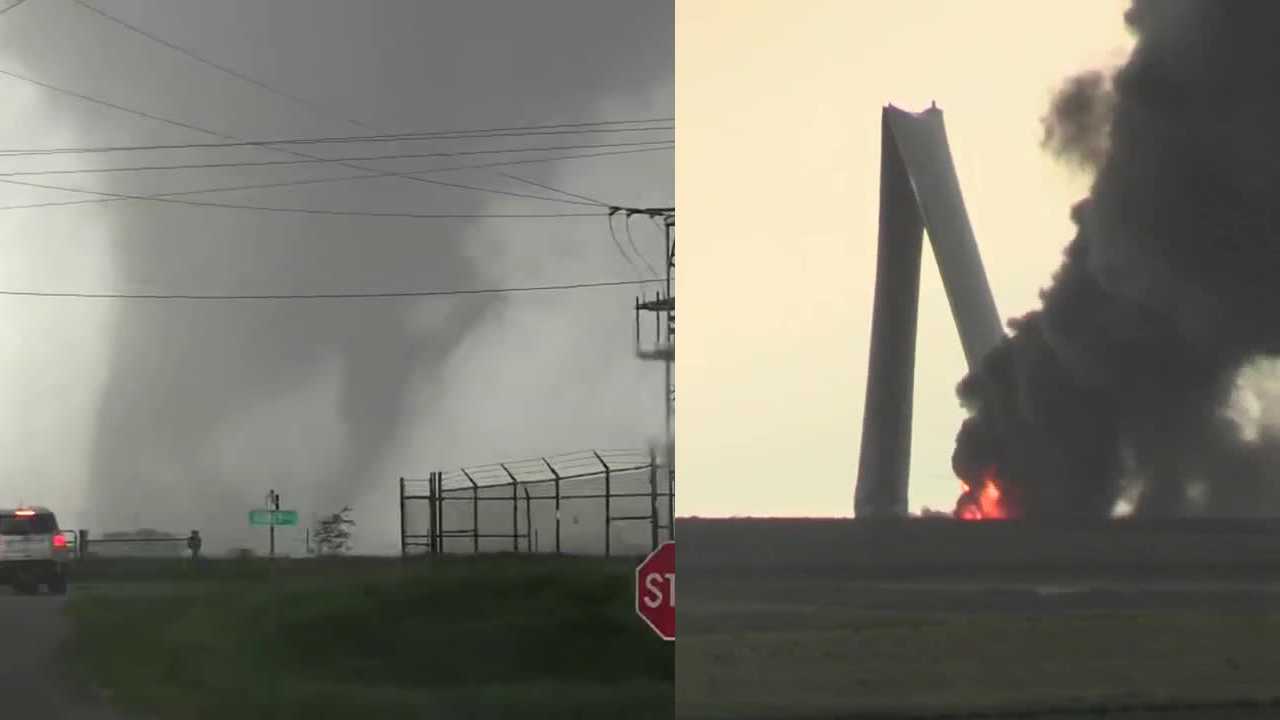Historical Tornadoes in Iowa

Tornado iowa – Iowa has a long history of tornadoes, with some of the most destructive tornadoes in the United States occurring within its borders. The state’s location in the center of Tornado Alley makes it particularly vulnerable to these powerful storms.
The mighty tornado that swept through Iowa left a trail of destruction, a stark reminder of nature’s unyielding power. In the aftermath, the community rallies together, seeking solace and rebuilding their lives. As the dust settles, the focus shifts to the present, where the latest updates on the iowa tornado today can be found.
The relentless spirit of Iowa shines through, determined to rise above the devastation and emerge stronger than before.
The following is a list of some of the most significant tornadoes to have occurred in Iowa:
| Date | Location | Intensity | Fatalities |
|---|---|---|---|
| May 25, 1878 | Oskaloosa | F4 | 3 |
| June 13, 1882 | Grinnell | F5 | 10 |
| June 28, 1902 | Dexter | F4 | 4 |
| May 11, 1947 | Woodward | F5 | 2 |
| June 24, 1953 | Worthington | F4 | 1 |
| May 6, 1966 | Fairfield | F5 | 0 |
| June 13, 1973 | Cedar Rapids | F4 | 0 |
| June 17, 1984 | Amana | F4 | 1 |
| May 25, 2004 | Parkersburg | F5 | 9 |
| May 25, 2011 | Dunlap | F4 | 0 |
Tornado Climatology of Iowa: Tornado Iowa

Iowa, located in the central United States, experiences a significant number of tornadoes annually. The state’s geographic location, atmospheric conditions, and terrain contribute to its high tornado risk.
Iowa lies within the “Tornado Alley” region, an area of the central and southern United States that experiences a high frequency of tornadoes. This region is characterized by a combination of warm, moist air from the Gulf of Mexico and cold, dry air from the north, creating an ideal environment for the formation of severe thunderstorms.
The seasonal distribution of tornadoes in Iowa follows a pattern similar to other parts of the Midwest. The peak tornado season occurs during the spring and early summer months, typically from April to June. However, tornadoes can occur at any time of the year in Iowa, including during the winter months.
Geographically, tornadoes can occur anywhere in Iowa, but there are certain areas that are considered to be at higher risk. The northwestern and central portions of the state have historically experienced the most tornadoes.
Tornado Safety and Preparedness
In the face of a tornado, your safety depends on being prepared and knowing what to do. A well-thought-out plan and emergency kit can make all the difference in the aftermath of a tornado.
The recent tornado outbreak in Iowa has left a trail of destruction in its wake. Communities are struggling to rebuild, and the search for survivors continues. For the latest updates on the situation, including information on how to help, visit iowa tornado today . The tornado iowa outbreak is a reminder of the power of nature and the importance of being prepared for severe weather.
Importance of a Tornado Safety Plan
Every household should have a tornado safety plan that Artikels what to do before, during, and after a tornado. This plan should include:
- Identifying a safe place in your home, such as a basement or interior room without windows.
- Establishing an evacuation route and meeting place outside your home.
- Designating a family member to be responsible for monitoring weather updates.
- Preparing an emergency kit with essential supplies like food, water, first aid, and a battery-powered radio.
Staying Safe During a Tornado, Tornado iowa
If a tornado warning is issued, act quickly:
- Take shelter immediately in your designated safe place.
- Lie down flat and cover your head with your hands.
- Stay away from windows and exterior walls.
- If you are outside, seek shelter in a sturdy building or lie flat in a ditch and cover your head.
Resources for Tornado Safety Information
For up-to-date tornado safety information and resources, visit the following websites:
Tornado Damage and Recovery
Tornadoes are one of the most destructive forces of nature. They can cause widespread damage to property and infrastructure, and can even be deadly. The types of damage that tornadoes can cause vary depending on the strength of the tornado and the area that it hits. However, some of the most common types of damage include:
- Structural damage: Tornadoes can cause severe structural damage to buildings, homes, and other structures. This damage can range from broken windows and siding to complete destruction.
- Infrastructure damage: Tornadoes can also damage infrastructure, such as power lines, roads, and bridges. This damage can disrupt essential services and make it difficult for people to get around.
- Environmental damage: Tornadoes can also cause environmental damage, such as knocking down trees and damaging crops. This damage can have a long-term impact on the environment and the economy.
Recovering from a tornado can be a long and difficult process. The first step is to assess the damage and contact your insurance company. Your insurance company will be able to help you file a claim and get the money you need to repair or replace your property. Once you have filed a claim, you can begin the process of rebuilding.
Rebuilding after a tornado can be a challenging process, but it is also an opportunity to make your home or business more resilient to future storms. There are a number of things you can do to make your property more tornado-resistant, such as installing storm shutters, reinforcing your roof, and planting trees around your home.
If you have been affected by a tornado, there are a number of resources available to help you. The Federal Emergency Management Agency (FEMA) provides financial assistance to individuals and families who have been affected by a disaster. The American Red Cross also provides assistance to disaster victims, including food, shelter, and clothing.
Tornadoes can be devastating, but they can also be overcome. With the help of your community and the resources available to you, you can rebuild your life and your home.
Stories of Tornado Survivors
There are many stories of tornado survivors who have overcome the challenges of rebuilding their lives after a tornado. Here are a few of their stories:
- John Smith was a farmer who lost his home and all of his crops in a tornado. He was able to rebuild his farm with the help of his community and the American Red Cross.
- Mary Jones was a single mother who lost her home and her job in a tornado. She was able to find a new home and a new job with the help of FEMA and the Salvation Army.
- Bob Brown was a retired veteran who lost his home and all of his belongings in a tornado. He was able to find a new home and get the help he needed from the VA.
These are just a few of the many stories of tornado survivors who have overcome the challenges of rebuilding their lives after a tornado. With the help of their community and the resources available to them, they were able to rebuild their lives and their homes.
Tornado Research and Mitigation
Advancements in tornado research have significantly enhanced our understanding of these destructive storms, leading to improved forecasting and warning systems that save lives. Technological advancements, such as Doppler radar and storm spotters, play a crucial role in tornado mitigation efforts.
Role of Research in Forecasting and Warning Systems
- Research has provided insights into tornado formation, movement, and behavior, enabling meteorologists to develop more accurate forecasting models.
- Numerical weather prediction (NWP) models use real-time data to simulate atmospheric conditions and predict the likelihood and severity of tornadoes.
- Tornado warnings are issued based on these forecasts, giving communities valuable time to prepare and take shelter.
Technology in Tornado Mitigation
Technology has revolutionized tornado mitigation efforts, providing valuable tools for detection, tracking, and warning.
Doppler Radar
- Doppler radar detects the movement of precipitation particles, providing information about wind speed and direction within a storm.
- This data helps meteorologists identify rotating updrafts, a key indicator of tornado formation.
- Doppler radar networks allow for real-time monitoring of storms, enabling early detection and warnings.
Storm Spotters
- Storm spotters are trained volunteers who provide ground-level observations of tornadoes and other severe weather.
- Their reports help verify radar data and provide valuable information about tornado location, size, and intensity.
- Spotter networks enhance the accuracy and timeliness of tornado warnings.
Successful Mitigation Efforts
Tornado mitigation efforts have yielded significant results, reducing the number of fatalities and injuries.
- Improved forecasting and warning systems have allowed communities to take timely action, such as seeking shelter or evacuating.
- Building codes have been strengthened to make structures more resistant to tornado winds.
- Public education campaigns have raised awareness about tornado safety and preparedness measures.
As research and technology continue to advance, we can expect further improvements in tornado mitigation, ultimately saving more lives and protecting property.
Iowa has experienced numerous tornadoes throughout its history, leaving behind a trail of destruction. For those seeking a comprehensive overview of these events, the iowa tornado map provides an interactive visualization of tornado tracks, intensity, and historical data. By exploring this map, individuals can gain insights into the frequency and severity of tornadoes in Iowa, aiding in preparedness and understanding of this powerful weather phenomenon.
The tornado that touched down in Iowa wreaked havoc, leaving a trail of destruction in its wake. Particularly hard-hit was the town of Greenfield, where greenfield tornado damage was extensive. Buildings were reduced to rubble, trees were uprooted, and power lines were downed, leaving the community reeling from the impact of the storm.
The tornado’s destructive path continued across Iowa, leaving a lasting mark on the state.
The recent tornado outbreak in Iowa left a trail of destruction in its wake. The greenfield tornado today was particularly devastating, causing widespread damage and loss of life. The tornadoes are a stark reminder of the power of nature and the importance of being prepared for severe weather.
The National Weather Service recommends that people have a plan in place for what to do in the event of a tornado warning, and to stay informed about the latest weather conditions.